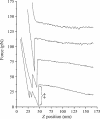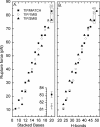DNA base pair resolution by single molecule force spectroscopy
- PMID: 15367697
- PMCID: PMC519116
- DOI: 10.1093/nar/gkh826
DNA base pair resolution by single molecule force spectroscopy
Abstract
The forces that hold complementary strands of DNA together in a double helix, and the role of base mismatches in these, are examined by single molecule force spectroscopy using an atomic force microscope (AFM). These forces are important when considering the binding of proteins to DNA, since these proteins often mechanically stretch the DNA during their action. In AFM measurement of forces, there is an inherent instrumental limitation that makes it difficult to compare results from different experimental runs. This is circumvented by using an oligonucleotide microarray, which allowed a direct comparison of the forces between perfectly matched short oligonucleotides and those containing a single or double mismatch. Through this greatly increased sensitivity, the force contribution of a single AT base pair was derived. The results indicate that the contribution to forces from the stacking interactions is more important than that from hydrogen bonding.
Figures







Similar articles
-
Sequence-dependent mechanics of single DNA molecules.Nat Struct Biol. 1999 Apr;6(4):346-9. doi: 10.1038/7582. Nat Struct Biol. 1999. PMID: 10201403
-
DNA: a programmable force sensor.Science. 2003 Jul 18;301(5631):367-70. doi: 10.1126/science.1084713. Science. 2003. PMID: 12869761
-
Study on intercalations between double-stranded DNA and pyrene by single-molecule force spectroscopy: toward the detection of mismatch in DNA.Langmuir. 2010 Sep 7;26(17):13773-7. doi: 10.1021/la102647p. Langmuir. 2010. PMID: 20698511
-
Force and function: probing proteins with AFM-based force spectroscopy.Curr Opin Struct Biol. 2009 Oct;19(5):605-14. doi: 10.1016/j.sbi.2009.09.005. Epub 2009 Oct 12. Curr Opin Struct Biol. 2009. PMID: 19822417 Review.
-
[Progress in the studies of DNA-protein interactions by atomic force microscopy].Sheng Wu Yi Xue Gong Cheng Xue Za Zhi. 2007 Oct;24(5):1172-6. Sheng Wu Yi Xue Gong Cheng Xue Za Zhi. 2007. PMID: 18027720 Review. Chinese.
Cited by
-
Mechanical characterization of base analogue modified nucleic acids by force spectroscopy.Phys Chem Chem Phys. 2021 Jul 7;23(26):14151-14155. doi: 10.1039/d1cp01985f. Phys Chem Chem Phys. 2021. PMID: 34180930 Free PMC article.
-
Demonstrating the uses of the novel gravitational force spectrometer to stretch and measure fibrous proteins.J Vis Exp. 2011 Mar 19;(49):2624. doi: 10.3791/2624. J Vis Exp. 2011. PMID: 21445050 Free PMC article.
-
Determination of base binding strength and base stacking interaction of DNA duplex using atomic force microscope.Sci Rep. 2015 Mar 16;5:9143. doi: 10.1038/srep09143. Sci Rep. 2015. PMID: 25772017 Free PMC article.
-
The mechanical stress-strain properties of single electrospun collagen type I nanofibers.Acta Biomater. 2010 Aug;6(8):2997-3003. doi: 10.1016/j.actbio.2010.02.050. Epub 2010 Mar 1. Acta Biomater. 2010. PMID: 20197123 Free PMC article.
-
Direct force measurements between siRNA and chitosan molecules using force spectroscopy.Biophys J. 2007 Aug 1;93(3):952-9. doi: 10.1529/biophysj.106.093229. Epub 2007 May 4. Biophys J. 2007. PMID: 17483179 Free PMC article.
References
-
- Breslauer K.J. (1995) Extracting thermodynamic data from equilibrium melting curves for oligonucleotide order–disorder transitions. Methods Enzymol., 259, 221–242. - PubMed
Publication types
MeSH terms
Substances
LinkOut - more resources
Full Text Sources
Miscellaneous

